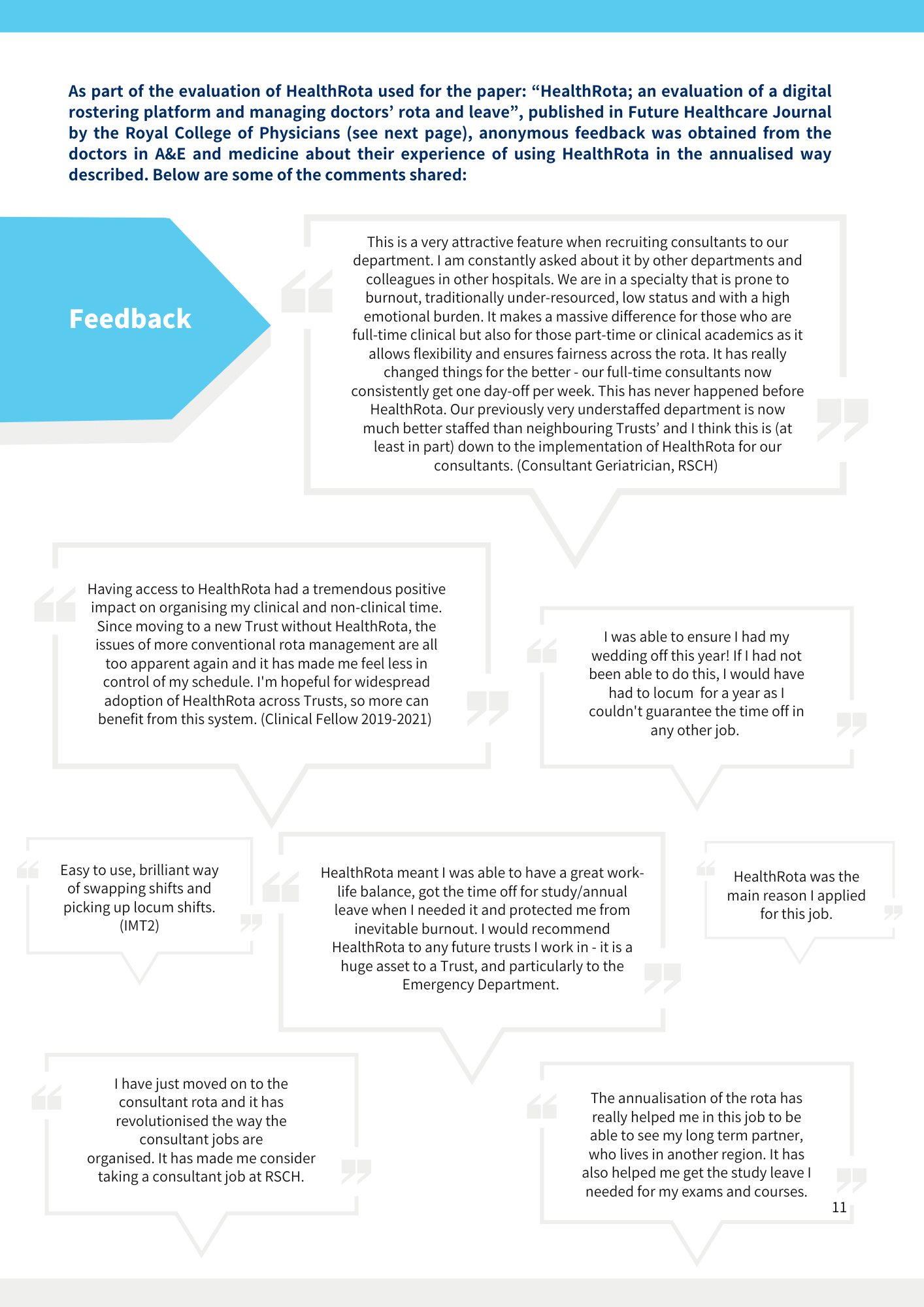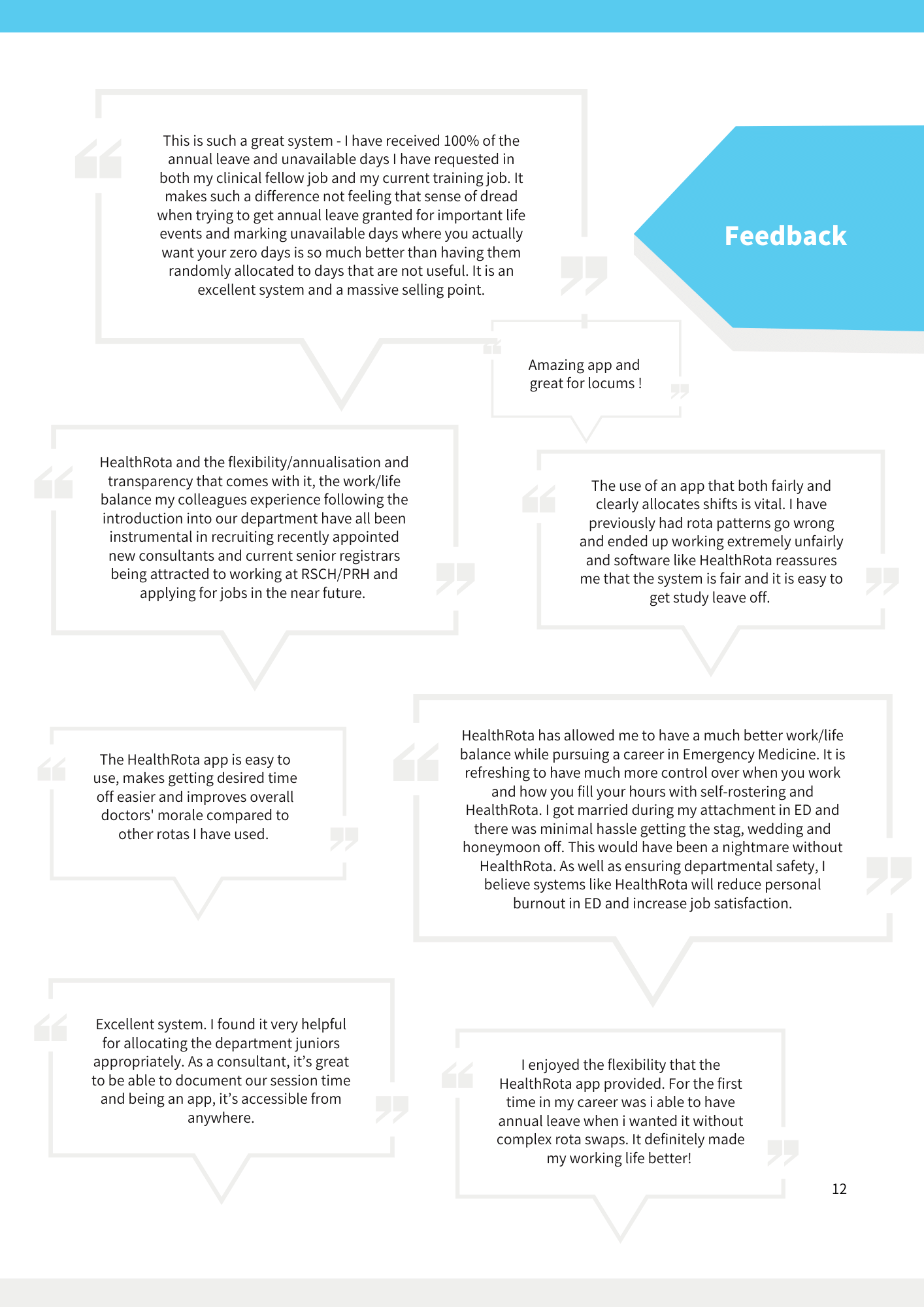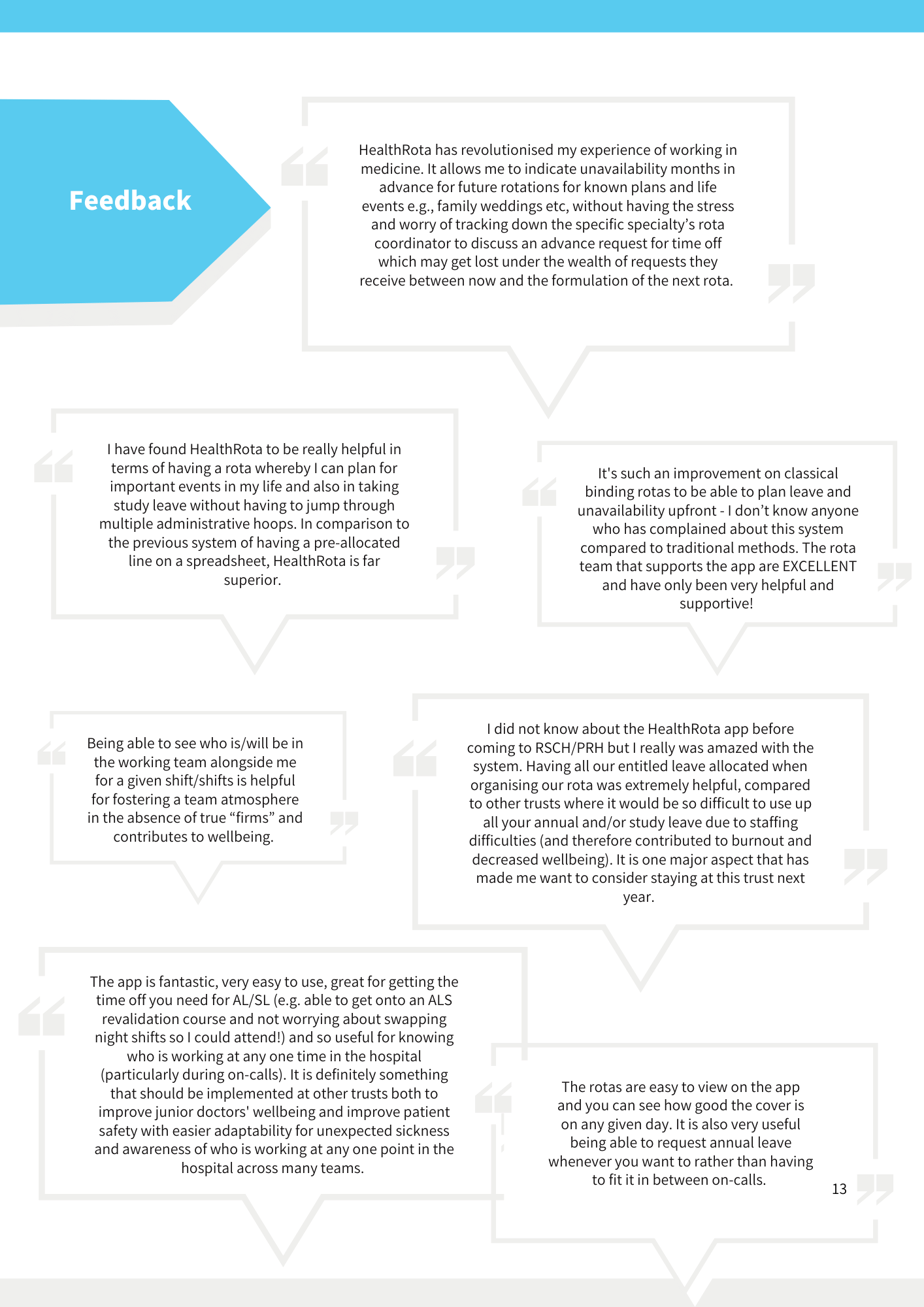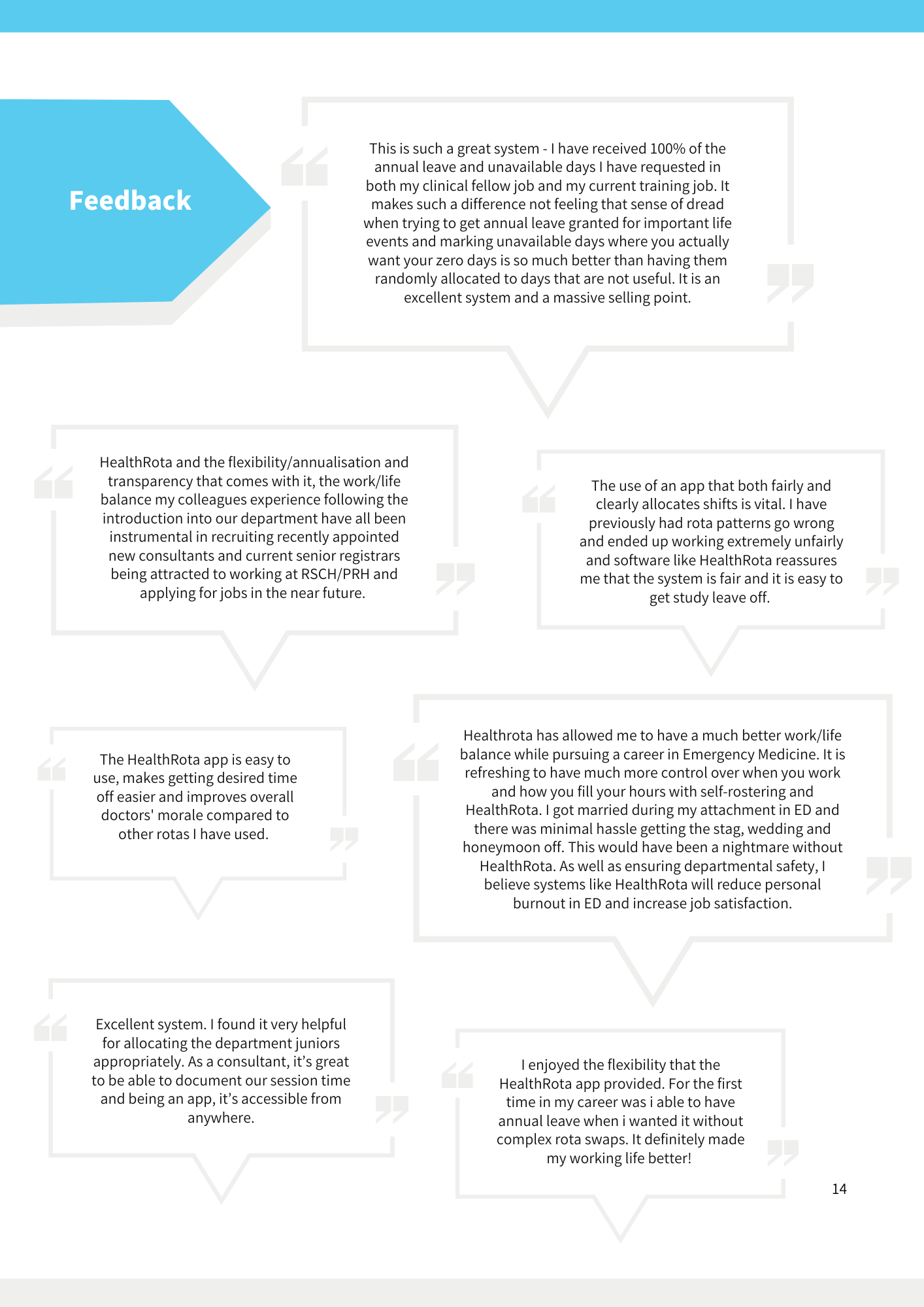Case Study Brighton creates a blueprint for tackling burnout, capacity issues and transforming workforce management with annualisation & e-Rostering

Discover how the UK’s first true annualisation and e-rostering solution supported the A&E and general medicine departments at Royal Sussex County Hospital in Brighton and the Princess Royal Hospital in Haywards Heath, to implement three aims which were previously thought to be mutually exclusive; improve patient care, create a happier workforce, and reduce locum costs.
Introduction
To provide safe and high-quality inpatient and emergency care, and with the cost of employing locum doctors becoming unsustainable across legacy Brighton and Sussex NHS Trust (Royal Sussex County Hospital (RSCH) and Princess Royal Hospital (PRH)), it was essential for doctors to be deployed in an optimal way, whilst supporting them to achieve a better work-life balance.
Traditional manual systems for planning and deploying the workforce are laborious and open to error. However, new ways of working and the implementation of the digital platform – HealthRota, has provided a more comprehensive approach to staff deployment in line with demand at the trust.
The innovative approach has given staff the tools to manage their time more easily, leading to improvements in morale, flexibility, and patient safety whilst helping the hospitals to completely eliminate planned junior doctor locum costs from August 2022 across A&E and General Medicine wards and on-call rota.

Challenges
With the individual rota for any given hospital doctor typically a composite of numerous rota’s - encompassing their base ward or department, clinical duties, on-call requirements, outpatient responsibilities, and non-clinical tasks such as medical management, training, research, and teaching, it’s clear to see why medical rotas can be extremely complex to manage.
Across many UK hospitals these rotas have been typically managed on spreadsheets which are not built with the functionality to support the complexities of medical rota systems. The outcome for staff is a rigid rota offering little flexibility and making the idea of achieving a better work-life balance an unrealistic prospect. Now, with added concerns about the staffing crisis, patient safety and the need to tackle the NHS backlog for elective care, the entire process has become untenable for many hospital trusts.
In the RSCH and PRH A&E and general medicine departments, medical rotas were previously managed using spreadsheets, often by different members of staff in varying departments. With no overview of the entire process, updates were not routinely made when a staff member was absent and worse, ward staffing was variable; with days when there were 4-5 junior doctors covering one ward, and 0-1 on another. The entire process was inefficient, time-consuming and led to potentially unsafe levels of staffing.
Furthermore, due to the introduction of the Major Trauma Centre and the need to provide 24/7 A&E consultant cover, the capacity issues became intensified. Recruitment and retention challenges led to low morale, burnout and general upset for consultants because of the lack of rota transparency and the uncertainty of knowing if they were working the correct number of hours that they were contracted for.
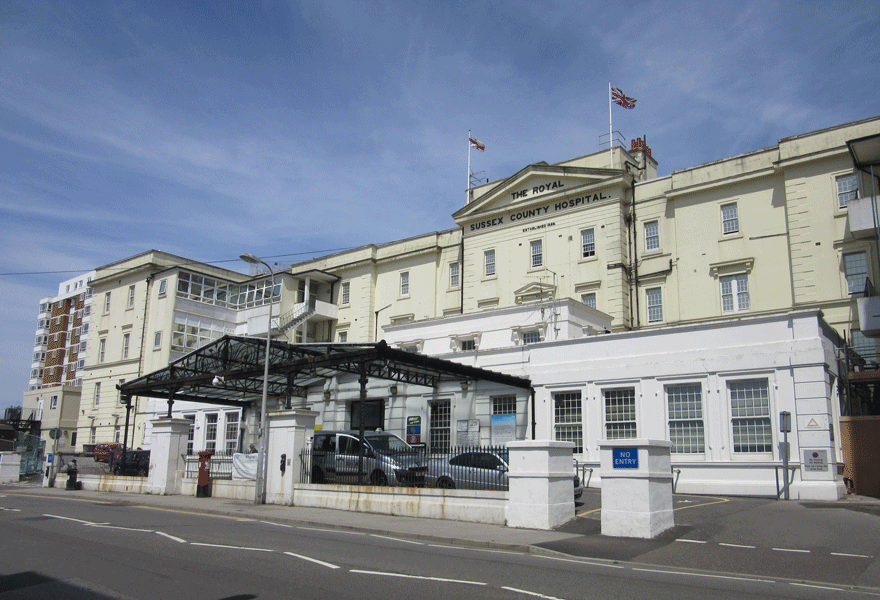
Solution
Workforce management pioneer and A&E consultant, Professor Rob Galloway, Amy Brown, Senior Workforce Coordinator, and their team, were looking for a way out with a comprehensive solution to all these challenges.
After several attempts to find the right e-rostering solution that truly allowed the use of annualised hours, in 2017, they discovered HealthRota. From here on, the team has worked in partnership with the HealthRota team to create a more intelligent, responsive and bespoke online self-rostering/self preferencing system that incorporates annualisation for the RSCH and PRH.
The team started out by using A&E as a proof of concept, before creating successful solutions for acute medicine and care of the elderly consultants and then all the junior doctors in general medicine wards across both hospitals.
The Implementation of HealthRota in Accident and Emergency (A&E)
The team began the roll out with A&E consultants followed by registrars. To do this, they calculated the number of professional activities (PAs) each group were required to do, minus any annual leave, study leave and bank holidays. This provided an accurate figure for the total number of PAs available within the team in a single year (annualisation), month or week. Using this figure, they were able to create a calculated shift structure, balancing staffing with the available PA allocation. Where clinical demand required additional PAs to be worked, the team could calculate the number of extra consultants and registrars needed, or have clarity on the locum requirements for that period.
Based on the annualised PA calculations, consultants and registrars were switched on to self-rostering, enabling them to pick their own shifts. This provided a level of flexibility staff had never experienced before; for example, some opted to work more weekends, whilst others selected early mornings or evenings depending on their personal and professional preferences.
Where a consultant or registrar wished to swap a shift, or simply take on a shift without a swap, the HealthRota platform is able to track change the hours worked (PAs) in real-time and allocate the correct number of PAs to the relevant staff member. With the ability for managers and rota coordinators to view up-to-date information about the work completed, consultants and registrars can effectively overwork or underwork during selected periods.
Under Professor Galloway’s leadership, the team came together and took collective responsibility for covering all the shifts between them. The agreement being that no shift was left unfulfilled, even after all leave and days in lieu were accounted for, and a key proviso that they did not owe, or were not owed, any PAs when they left their job. In return, consultants and registrars achieved unparalleled flexibility, a positive and conducive working environment, improved peer-to-peer team working and a more robust support structure for their junior doctors.
The shifts follow the person. Every person has a set number of hours to do, but they can effectively work when they want
Professor Galloway said: “It enabled a consultant that was recruited on a clinical 4 PA contract to work in weeks of high intensity; working 10-16 PAs per week so she could take time off for several weeks to continue being an expedition doctor.
“The shifts follow the person. Every person has a set number of hours to do, but they can effectively work when they want as long as the group of doctors rostered can cover the shifts needed.”
He adds: “A few weeks ago, my son had a football match and I wanted to go and watch him so I put my shift up on HealthRota and a colleague took it off me, taking the PAs from me but without a swap being needed. It started to change people’s flexibility and their way of life as A&E consultants. This impact cannot be under-estimated; I remember being at a Christmas party when three partners came up to me and said that it literally saved their marriage!”
Since the implementation, capacity and demand planning has become much easier to manage, and with data now available on the PA requirements of individual departments, business cases have been written and granted for recruitment purposes.
These developments have enabled the successful implementation of a 7-day-a-week consultant night shift rota and facilitated an increase in the number of employed consultants from 8 full-time equivalents (FTE) to 24.
Adapting for Junior doctors in A&E
Shortly after, the approach was adopted for rostering junior doctors (senior house officers and F1 level) in A&E. This involved working out annualised hours, obtaining their request for when they didn’t work (self-preferencing rotas) and creating bespoke rotas from basic templates which provided the cover needed, while allowing the flexibility that doctors wanted. The software also ensured that the doctors only worked the number of hours they were contracted for and worked an equal amount of out-of-hours shifts (which on traditional un-adapted templates is impossible to create). By rostering them for two hours less than their contracted hours, it also ensured they were guaranteed their Health Education England (HEE) mandated two hours a week self-development time.
This enabled the department to recruit high-quality post F2 clinical fellows, and start to improve clinical care, junior doctor welfare and reduce locum costs. In addition, the clinical fellow jobs had 25% non-clinical time which were also rostered within HealthRota and started to have added improvements for the department – teaching their medical students and undertaking quality improvement projects.
Weekend cover has improved by enlisting foundation level doctors (such as academics) who do not routinely work in A&E, via HealthRota. This has completely eliminated the use of routine locum staff during the weekends when cover was previously difficult to coordinate.
All of these measures also led to a dramatic decrease in exception reporting, and high praise from the Trust’s Guardian of Safe Working.
Expanding in to General Medicine and Care of the Elderly
Following the successful roll-out of consultants in A&E, acute medical consultants and care of the elderly consultants adopted the same system of annualisation, but adapted it so that they could provide the continuity required for their ward and clinic work.
This improved the department’s ability to recruit and retain staff and improve the well-being of the consultant body. Following this, Professor Galloway and the team created the same benefits for junior doctors (registrar to F1 level) across General Medicine and Care of the Elderly wards, across RSCH and PRH hospitals. They use similar systems of annualisation to A&E but with some adaptations to how they created the rotas because continuity of care is paramount for ward patients and junior doctor training, whereas in A&E this is not the case.
The new rotas enable doctors to specify the days they cannot work and when they want to take their study and annual leave (self-preferencing) . This can be requested and is approved months before they start the job. Templated rotas are then re-configured to ensure that all shifts are covered, taking into consideration the needs for continuity.
Traditionally, fixed templates restricted how leave was processed. Doctors could only book annual leave when they were rostered for ‘standard days’, and they would only find out if that request had been approved or not up to 6 weeks prior to starting the post. This was a key frustration for junior doctors who found it difficult to plan and manage their personal commitments in line with their professional responsibilities. In comparison, the new approach allows junior doctors to choose their leave months in advance. And, unless there are significant shortages in capacity i.e., during Christmas holidays, this time is almost always honoured.

Since the implementation, capacity and demand planning has become much easier to manage, and with data now available on the PA requirements of individual departments, business cases have been written and granted for recruitment purposes.
Amy said: “It’s great because it very clearly shows if you have the capacity or not to provide the service that you need. Where we have the capacity, we can move people around to ensure an even staffing structure, and where there is not the capacity long term, it provides objective data and a transparent mechanism for creating a business case to recruit more doctors, rather than rely on locum staff.”

Results
The new approach to rostering in Brighton has led to an overall increase in job satisfaction among doctors, enabling the Trust to recruit and retain a pool of talented and experienced staff.
From August 2022, optimal staffing levels have been calculated for each ward area and A&E department in RSCH and PRH, with clear visibility about the number of doctors required. Due to the flexibility of the rota system, all these shifts have been created and evenly filled.
78 FTE SHO and registrar fellows across medicine and A&E at both sites have been recruited, all with post F2/NHS experienced/UK trained doctors, to work alongside the HEE trainee doctors. The successful recruitment was only possible because people specifically wanted to come to work at RSCH/ PRH because of the flexible rota. As a result, there are no planned locum costs from August 2022, except to cover unexpected sickness. This would not be possible with traditional templated rota systems.
Annualisation with automated PA calculations
Annualised rotas and self-rostering/self-preferencing has created an equal distribution of shifts, reducing levels of burnout and ensuring that doctors only work the hours that they are paid for.
By using a combination of period of activity and hourly contracts for consultants, middle grade and junior doctors, all doctors are empowered with the flexibility to choose the amount of clinical work they wish to do. This includes a number of F3 and F4 doctors who work 33% , 50% and 75% contracts - with everyone having the ability to work for extended periods and take time away for travelling or childcare, for example. This typically provides the flexibility of locum staff, but with the skills and experience of a permanent workforce.
In comparison to traditional rostering systems, the new approach means that rotas are created and structured only after all types of leave have been calculated. This provides the flexibility that staff have asked for, whilst maintaining the principle that shifts are distributed equally, regardless of the day or ward area. It also helps to create rotas that are planned to be locum free, saving the Trust millions of pounds each year. Annualisation has also enabled:
- More effective planning and rostering, significantly reducing admin time.
- Annual leave to be booked up to a year in advance.
- Better utilisation of resources with optimised staff deployments.
- Rotas that are developed with all types of absence factored in at the point of creation, with the appropriate number of staff and the skill mix automatically mapped for each shift.
- Consistent daily staffing numbers which are not depleted by leave requests.
- The flexibility to work when and during hours that suit the rota and the individual with 98% of annual requests agreed.
- Fair and equitable distribution of shifts, regardless of the specific line of the template used.
- Ability to factor in regular periods of rest into templates.
- Accurate work schedules based on templates or individual shifts.
- Real-time compliance and calculation of hours when swapping or amending shifts, ensuring that individuals do not work more or less hours than contracted for, and that the rota remains compliant.


Greater flexibility and work-life balance with self-rostering
With doctors able to mark themselves as ‘unavailable’ or ‘available’ using the HealthRota application on their desktop or mobile devices, emergency and medicine departments can operate a fully flexible and bespoke rota system that is almost entirely locum-free (except for last- minute sickness).
Shift swapping provides the functionality to utilise available staff more efficiently, rather than relying on the fixed and inflexible templates of the past. Staff have their rotas emailed directly to their online calendar and can easily swap shifts, request annual leave and self-roster independently – all via the mobile app, giving them greater ownership and control over their own time. This also removes the dependence on rota coordinators to do the same, saving valuable time and resources.
Enabling a successful crisis response during the Covid-19 pandemic
With the HealthRota e-rostering system already in place and demonstrating significant benefits prior to the Covid-19 pandemic, the Trust made the decision to roster the entire junior workforce onto the platform using annualised rotas. This allowed the team to seamlessly initiate a crisis response which prevented doctors moving between wards by providing a temporary base ward. Each ward was rostered with nine doctors, providing cover for 24 hours-a-day, 7 days-a-week. This allowed the Trust to honour 100% of the doctor’s annual leave entitlements and enabled staff to take time off when they requested.
Amy said: “It saved us. It was amazing.”
She adds: “If you can imagine a control room with your Chiefs planning your team, that is what we did. We were able to stop everyone from moving around and still ensured our workforce got regular breaks, their annual leave when requested and that we still had sufficient capacity to meet the demands of the Covid pandemic despite the number of staff not able to work. We built resilience into the team and so during wave one, not one doctor felt that they were being overworked. It was unbelievable. ”
The HealthRota software was able to adapt to the new requirements. As a result, A&E and medicine had zero locum requirements even with all the covid related sickness during the first wave of the pandemic. The redeployments had no impact on the commercial use or cost of the platform - and furthermore, additional functionality was developed by HealthRota ‘just in case’ it would be needed by the team.

Conclusion
As someone that had witnessed the impact of poor rostering practices on medical teams for many years, Professor Rob Galloway was compelled to instil a new culture of transparency and ownership. He understood that empowering doctors with the freedom and flexibility to work when they wanted, would in turn lead to a sense of collective responsibility for managing the demands of the A&E and general medicine departments.
Despite the early challenges with effective and efficient deployment of staff, and the rising costs of using locum doctors to fill the gaps, Professor Galloway and his team, supported by HealthRota, have served to resolve the issues facing the A&E and medicine departments, while also improving the quality of working life for the clinical professionals using the system.
Annualisation and self-rostering has created a sustainable and future-proofed approach to workforce management. It has given staff the flexibility to work full-time, part-time, or any hours they choose over a given year. This way, they can opt to work periodically, or more intensively over a selected period and take the rest of the time off as they choose – all without impacting the running of the emergency department.
Patient safety has also increased with the ability to provide more clinical cover on the wards outside of the usual 9am - 5pm hours seen in other hospitals. Talking about the difference e-rostering has made for patients and his team, Professor Galloway says: “We have completely transformed A&E and medical staffing at RSCH and PRH.”
With sole responsibility for rostering 160 doctors every 4 months, across 15 specialties, Amy said: “You go on Twitter, and you see ‘burnout,’ ‘no flexibility,’ ‘cannot get my annual leave’ or worse, people leaving the NHS! And yet, we are sitting here with the solution. We have mitigated all these issues and the benefits have been unreal!”
The transformation has also been cited as a positive factor amongst several professionals. In a recent survey conducted by the Trust, a consultant stated: “I don't know why this isn't used at every trust. It brings HR into the 21st century. It delivers better care for patients as staffing levels are more uniform, but most importantly, it makes for a happier workforce.”
Another said: “I did not know about the HealthRota app before coming to RSCH and PRH, but I was really amazed with the system. Having all our entitled leave allocated when organising our rota was extremely helpful, compared to other trusts where it would be difficult to use up all your annual or study leave due to staffing difficulties, which was a major contributing factor leading to burnout and decreased wellbeing. This is one major aspect that has made me want to consider staying at this Trust next year.”
The HealthRota e-rostering digital platform has been central to the approach pioneered by Dr Galloway in Brighton. For his contribution to NHS workforce management, in 2021, Dr Galloway was nationally recognised in the HSJ top 20 wildcard list among the people that NHS England and the Health Secretary, ‘would do well to listen to’. He was named for using innovative approaches to juniors’ rotas, including self-rostering and annualised hours.
Overall Benefits
- All rotas are annualised, with all types of annual leave, days off in-lieu, and non-shop-floor time is factored into the rotas. From August 2022, the only locum requirements are to cover unexpected sickness across A&E and the medical wards.
- All available posts have been recruited for, with locum savings used to fund and improve staffing levels. In five years, the Trust went from seven consultants and seven registrars (for two sites) to 23.8 full-time equivalent (FTE) consultants and 20 registrars (=43.8). In seven years, fellow doctor numbers have increased from 4 in A&E and 6 in medicine to 78 FTE across both departments.
- The Trust benefits from 24/7 consultant A&E cover at Brighton, and cover between 8am and 10.30pm every day of the week at the Princess Royal hospital.
- The cost of using locum doctors has been curtailed. For example, before the annualised rota system was introduced, £1.3m was spent on locums at RSCH and PRH in A&E alone. The year after annualisation was implemented (2018), the locum costs were less than £50K.
- For 2022-23, the only projected locum need is to cover sickness absence. This is projected to be less than 300K a year for the whole of A&E and medicine across two sites.
- With objective data available for capacity and demand planning, and with self-rostering and annualisation cited to be a positive factor for staff teams, it has proven easier to recruit UK trained post F2 doctors to clinical roles.
- The Trust has the data available instantly to assess who can cover shifts or who is available should a major incident occur.
- The administrative time required to run rotas has been drastically reduced.
- Aside from any ongoing challenges of Covid-19, A&E and general medicine is almost consistently run with the staffing it needs. This has enhanced out-of-hours cover, improved clinical safety, patient experience and outcomes.
- Doctor wellbeing has improved with burnout rates falling significantly due to better work-life balance and the flexibility to work when preferable, with easy access to self-rostering on the HealthRota app.
- The learning environment has been enriched with more support available for junior doctors. The Trust has been able to recruit clinical fellows who work 75% clinical time, and 25% non-clinical time in areas such as research, simulation and education.
- With 44 FTE educational fellows delivering over 16,000 hours of undergraduate education, the Trust has positively impacted on the education of its medical students, transforming feedback of students. The administration team roster the educational fellow’s rotas to ensure that there are fellows available when the students are on placement. In 2021, Brighton and Sussex Medical School came 3rd in the national student survey for medical school with an overall 95% student satisfaction. The educational fellows were a significant contributor to this performance.
- The Trust now has 14 research fellows starting multiple projects in line with the Trusts’ key research objectives.
Tweet Download More Case Studies
Additional Information
The Benefits of Annualisation (short video)
The BMA has supported the benefits of this annualised approach as shown in this video.
Accolades awarded based on the Annualised approach
- August 2022: Shortlisted for the 2022 (HETT) Health Excellence Through Technology Unexpected Innovation Awards – Digital Workforce Category
- June 2021: HSJ Wildcard top 10 influence on NHS workforce ideas. Awarded to Rob Galloway for work with Healthrota on medicine ward rotas.
- May 2018: BMJ 2018 Innovation Team of the Year- highly commended award for staffing solutions to A&E.
- November 2017: HSJ Award - highly commended within the workforce category formwork on innovative staffing solutions for medical staffing using annulistaion and clinical fellows.
- October 2017: Winner of RCEM Quality Improvement Project, Award in celebrating 50 years of Emergency Medicine. Transforming A&E Clinical care by revolutionising medical staffing using annualisation, self-rostering and clinical fellow posts.
- August 2017: RCEM Excellence Award in celebrating 50 years of Emergency Medicine. Transforming A&E Clinical Care.
